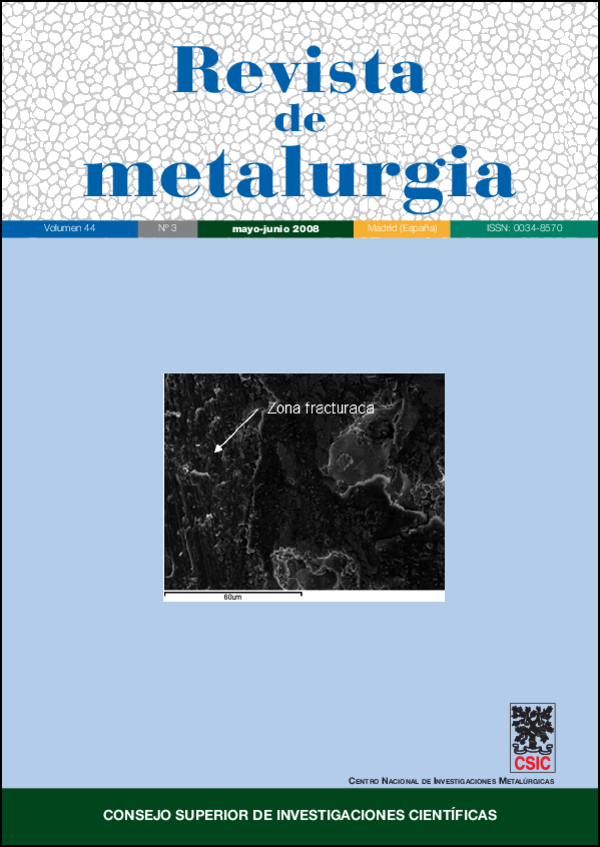Wear behaviour of WC plasma sprayed coatings with micro and nanostructured powders
DOI:
https://doi.org/10.3989/revmetalm.2008.v44.i3.110Keywords:
Plasma spray, Tungsten carbide, Hard metal, TribologyAbstract
The aim of the present work is the study of wear behaviour of different WC coatings deposited on stainless steel substrate by means of atmospheric plasma spraying (APS). Two types of WC commercial powders, with different metal binder (12% Cobalt and 10% Nickel) have been deposited in order to analyse the influence of the metal matrix and thickness of the coating in tribological properties.The microstructure of the depositions was characterized using scanning electron microscopy (SEM) and X-ray diffraction analysis (XRD). On the other hand, tribology characterization of the coatings was made by pin-on-disk wear tests against alumina (2400HV) and silicon nitride (1600HV) ceramic balls, without lubrication. Wear rates and friction coefficient evolution have been calculated. Finally, wear tracks and wear debris have been analysed with the help of SEM.The results of each pair of tested materials show different mechanisms of wear related to the nature of the ball that has been used, obtaining higher wear rates with silicone nitride ball..In a second phase of the study, in order to examine the influence of the initial particle size on the wear properties of the coatings, cobalt based coatings have been analysed with different initial particle size (micrometric and nanometric particles).Results show that nanostructured coatings have higher wear resistance than microstrutured ones for high loads. However for low loads, behaviour is similar in spite of the microstructural differences appreciated.
Downloads
References
[1] P.H. Shipway y D.G. Mccartney, Wear 259 (2005) 820-827. doi:10.1016/j.wear.2005.02.059
[2] Q. Yang y T. Senda,Wear 254 (2003) 23-34. doi:10.1016/S0043-1648(02)00294-6
[3] J. Voyer y B.R. Marple, WEAR 225-229 (1999) 135-145. doi:10.1016/S0043-1648(99)00007-1
[4] J. Guilemany y J. Miguel, Surf. Coat. Tech 140 (2001) 141-146. doi:10.1016/S0257-8972(01)01033-7
[5] C. Tekmen, H. Cetinel, A. Turk y E. Celik, Key Eng. Mater. 264 (2004) 589-592.
[6] M. Morks y Y. Gao, Surf. Coat. Tech. 199 (2005) 66-71. doi:10.1016/j.surfcoat.2005.02.159
[7] P. Chavivibul, M. Watanabe, S. Kuroda y K. Chinoda, Surf. Coat. Tech. in press (2007). doi:10.1016/j.surfcoat.2007.06.026
[8] K.H. Baik, J.H. Kim y B.G. Seong, Maert. Sci. Eng. A 449 (2007) 846-849. doi:10.1016/j.msea.2006.02.295
[9] M.F. Morks y Y. Gao, Mater.Lett. 60 (2006) 1.049-1.053.
[10] Y. Zhu y K. Yukimura, Thin Solid Films 388 (2001) 277-282. doi:10.1016/S0040-6090(01)00805-7
[11] Y. Zhu y C. Ding, Ceram. Int. 27 (2001) 669- 674. doi:10.1016/S0272-8842(01)00016-5
[12] N. Candela, A. Lopez, O.A. Ruano y J.A. Jiménez, Rev. Metal. Madrid 41 (2005) 351-356.
[13] D.A. Stewart, P.H. Shipway y D.C. Mccartney, Wear 225 (1999) 789-798. doi:10.1016/S0043-1648(99)00032-0
Downloads
Published
How to Cite
Issue
Section
License
Copyright (c) 2008 Consejo Superior de Investigaciones Científicas (CSIC)

This work is licensed under a Creative Commons Attribution 4.0 International License.
© CSIC. Manuscripts published in both the printed and online versions of this Journal are the property of Consejo Superior de Investigaciones Científicas, and quoting this source is a requirement for any partial or full reproduction.
All contents of this electronic edition, except where otherwise noted, are distributed under a “Creative Commons Attribution 4.0 International” (CC BY 4.0) License. You may read the basic information and the legal text of the license. The indication of the CC BY 4.0 License must be expressly stated in this way when necessary.
Self-archiving in repositories, personal webpages or similar, of any version other than the published by the Editor, is not allowed.
















